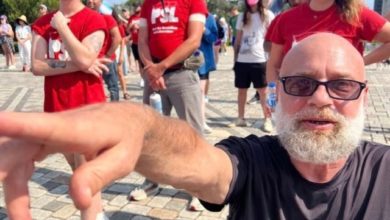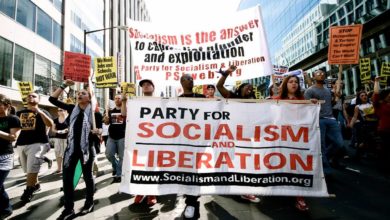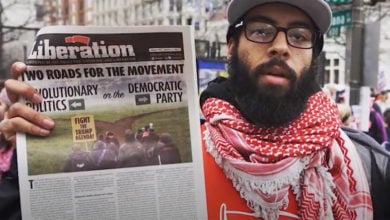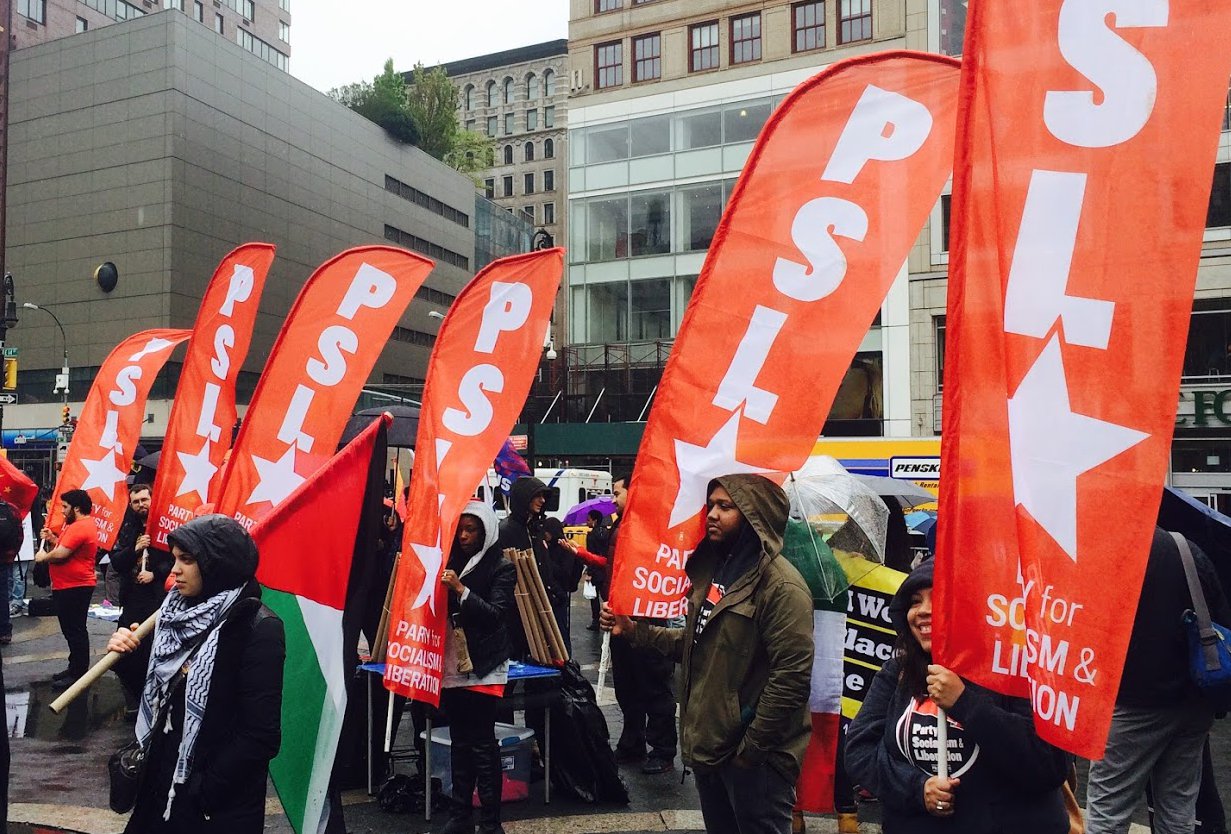 |
The Party for Socialism and Liberation exists to promote the interests of the working class and oppressed peoples in the United States. Facing the most powerful capitalist class of bankers and owners with the most centralized and far-flung military apparatus that the world has every seen, the PSL seeks to overturn the existing social order and reorganize it on a new basis with the working class in political power and the economy organized in the interests of the majority class of working and oppressed people.
—From the Preamble to the Constitution of the PSL
The Party for Socialism and Liberation held its First National Congress Feb. 13-15 in Los Angeles. It was a historic event for the organization, and a step forward for the communist movement in the United States, the heartland of world imperialism.
Delegates from PSL branches in California, New York, Washington, D.C., Washington State, Florida, South Dakota, Massachusetts, Illinois, Connecticut and elsewhere attended the Congress, which took up major tasks, including ratifying the party’s Constitution and Program, electing a Central Committee, and discussing upcoming initiatives and organizational challenges. The delegates were the leading cadre of the organization, with years of experience and struggle behind them. Non-voting delegates who represented new areas of the PSL’s growth in the country also attended.
The PSL announced its intention to move to holding delegated congresses at its June 2007 National Party Convention. Preparations for this move toward a higher form of democratic centralism began at that time, and the elected party leadership directed the PSL to achieve this goal.
Democratic centralism governs the way that communist parties operate. It is how the PSL is organized. In practice, it means the widest possible proletarian democracy in discussion, and unity in action. Democratic centralism has a long history in the world communist movement, traced back to the Bolshevik Party in Russia and, later, the Soviet Union. Under the norms of democratic centralism, the party congress is the highest body of a communist party while it is in session.
In the three months prior to the Congress, the PSL’s membership in each branch and region held a series of internal meetings to discuss draft documents, make amendments and suggestions, elect delegates to attend the Congress, and generally provide the best possible venue to hear every member’s questions, ideas and concerns. The meetings set the stage for the Congress.
The months of intense preparation paid off, as the Congress ran smoothly and completed all that it set out to do. There were intense discussions and debates, practical questions, proposed initiatives, and so much more. The Congress brought the PSL together even more as a cohesive organization and laid the groundwork for the party’s initiatives to come.
PSL member Muna Coobtee opened the Congress: “In the five years since it was founded by a relatively small number of cadre, the PSL has developed numerically both in membership and in cadre formation. Since our founding, we have grown six fold, and we are continuing to recruit on a steady basis. We now have members in over 20 states and significant branches in every region of the country.”
Brian Becker, PSL member, discussed the historic reality of the Congress: “Our work over the last five years has been non-stop. Now, for the first time, we have a delegated Congress. And we have a Party that is taking the next steps in the formation of a genuinely democratic-centralist organization.
“We need to be humble. We are laying the foundations of a large-scale communist party, but the conditions for the development of such a party do not all arise at once. However, we know that the material conditions could lead to that struggle at any time. It is our job to build a party that can lead the struggle that aims for the conquest of political power by the working class. If the upsurge comes, and there is no party, the possibility of a socialist revolution in an advanced capitalist country is not possible. We are here to build such a party.”
A struggle-based program
Two of the most major tasks achieved by the Congress were discussing, amending and ratifying the new PSL Constitution and Party Program. The Constitution is the product of years of work. Prior to its final passage, 43 separate amendments were debated and voted on. With its unanimous ratification by Congress delegates, it replaces the Interim Constitution, which was adopted in February 2006, as the party’s governing organizational document.
The Party Program, also adopted unanimously after two days of debate and discussion on 71 separate amendments, is a major step forward for the PSL. It crystallizes the party’s political analysis of the period and the conditions facing the working class under capitalism, and strongly asserts the necessity of socialist revolution in the United States and internationally.
The Party Program states: “For the working class, revolution is a necessity and a right. The most brutal aspects of capitalism will not go away unless there is a socialist revolution. Only a revolution can do away with the rule of the capitalists once and for all.”
The Program also sets forward what would happen if a workers’ government came to power in the United States. Its struggle-based orientation is clear. The Program states that “a new revolutionary government shall be established and run by and for the workers and oppressed peoples,” and that the “present capitalist government … shall be abolished.” What follows is a series of measures meant to reflect workers’ power and a reorientation of society toward the interests of working and poor people.
To that end, the main function of the workers’ government “shall be planning and administering the economy in the interests of working people.” What follows are a series of measures to address workers’ needs, such as guaranteed housing, free education, free health care, jobs for all and more. The Program states that “Poverty shall be eradicated by providing a guaranteed living income for any worker who is not able to find or hold a job,” and “[c]itizenship rights shall be granted to any person living in the United States.” Also enumerated are measures to eradicate “racism, national oppression and all forms of exploitation and bigotry.”
Congress delegates also elected the party’s directing leadership body, the Central Committee. The Central Committee is the highest leadership body between Party Congresses. Delegates were nominated, and voting was held, to fill these leadership positions.
PSL member Gloria La Riva addressed the Congress on this point: “To be elected to the Central Committee, members must be skilled leaders with experience and proven dedication. They must be cadres who can direct the work of the party and have a firm and full grasp of the party’s political program.” La Riva continued, “Central Committee members must be the party’s most reliable cadre and always be willing and able to carry out the responsibilities of leadership.”
Other business discussed at the Congress included party fundraising efforts, and PSL strategy, tactics and tasks in 2010. Special attention was paid to improving the party’s national organizational apparatus, building new branches, increasing the visibility of the PSL’s organs, Liberation newspaper and PSLweb.org, and building the upcoming national public party conference in Los Angeles on Nov. 13-14, 2010.
An Internal Memorandum written for the Congress and discussed by the delegates, entitled “Building the PSL in 2010: Assessment, evaluation and proposals for going forward,” best sums up the party’s challenges: “The current objective situation presents to the party dual tasks: We must build a new workers’ movement based on the issues of the day, and at the same time strengthen the position of the ideological current that promotes socialism and communism.”
The robust discussions and practical, yet optimistic spirit of the deliberations were palpable throughout the three-day event. The close of the Congress marked a new stage for the PSL and new tasks for the revolutionary movement in the United States.
As the PSL wrote in its first published article, in July 2004: “The magnitude of our tasks will be matched by our determination to win. Workers and oppressed people of the world, unite!”






